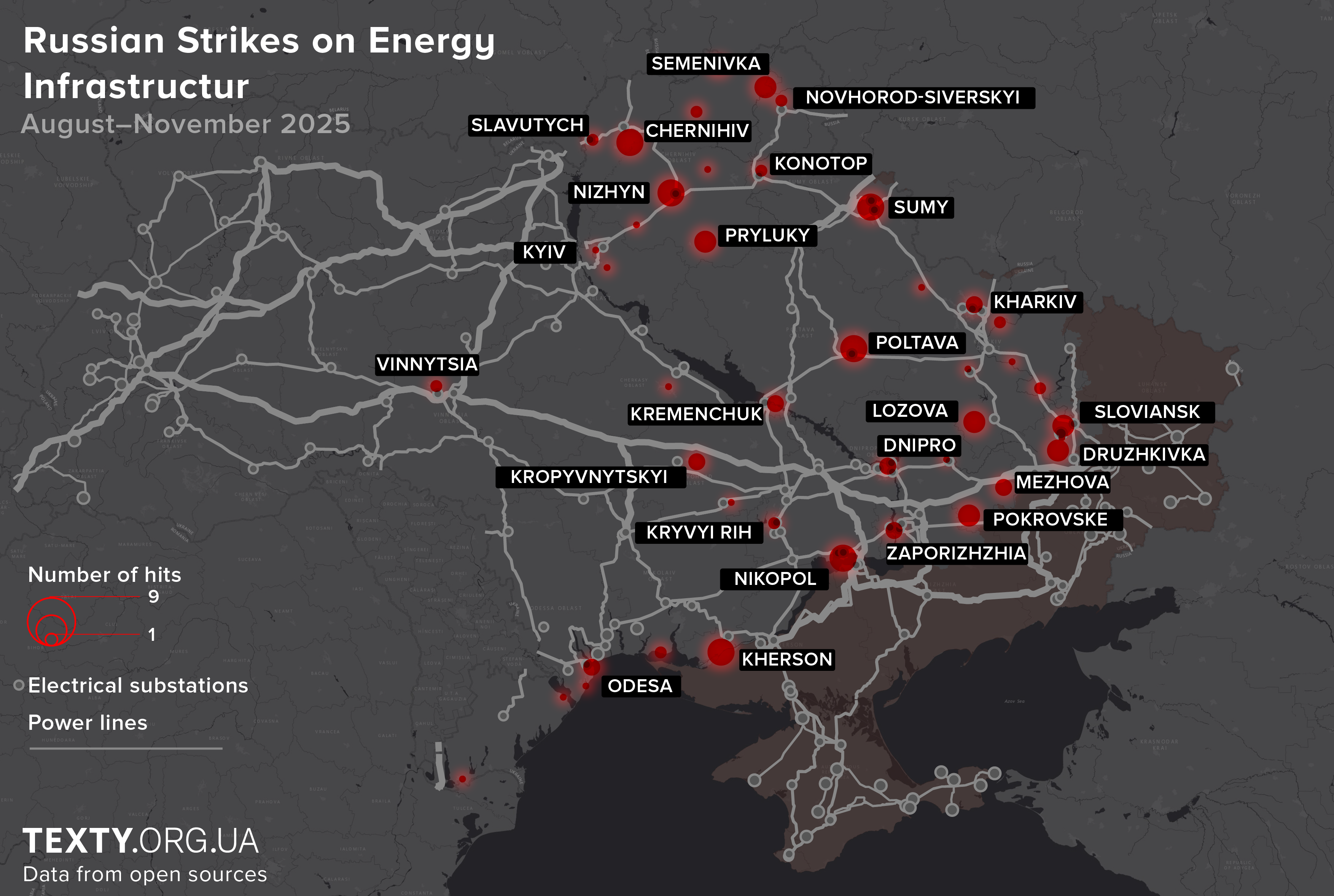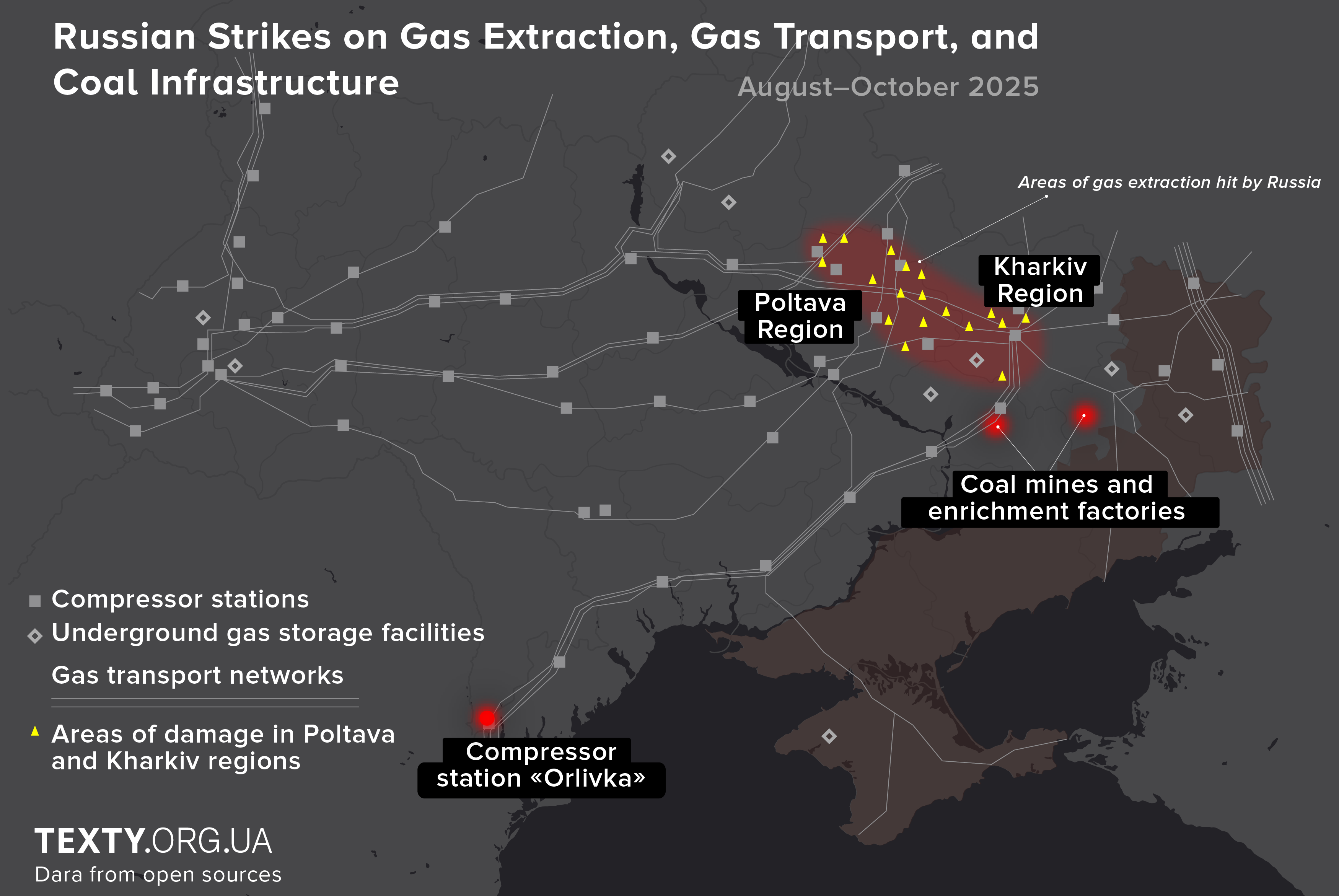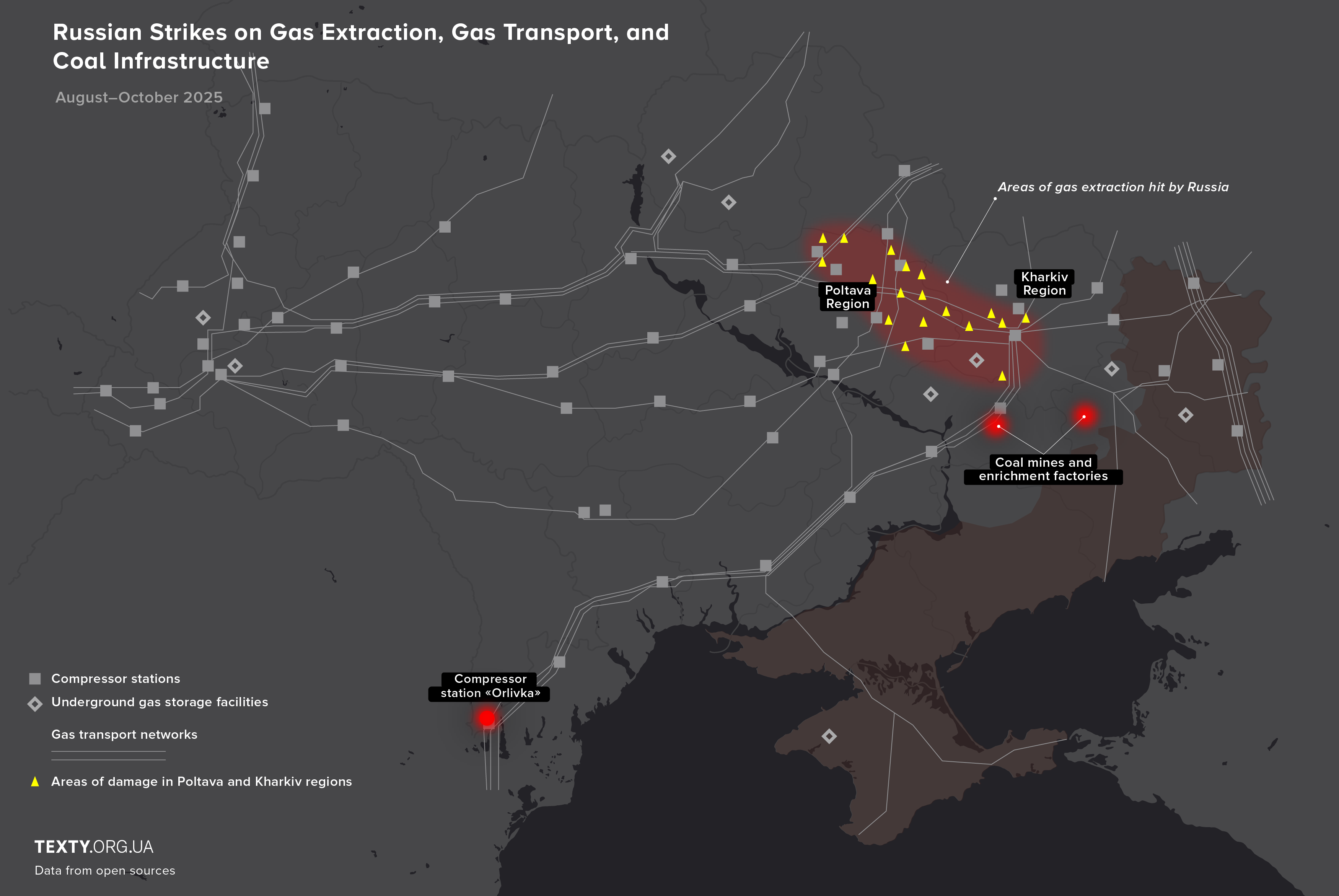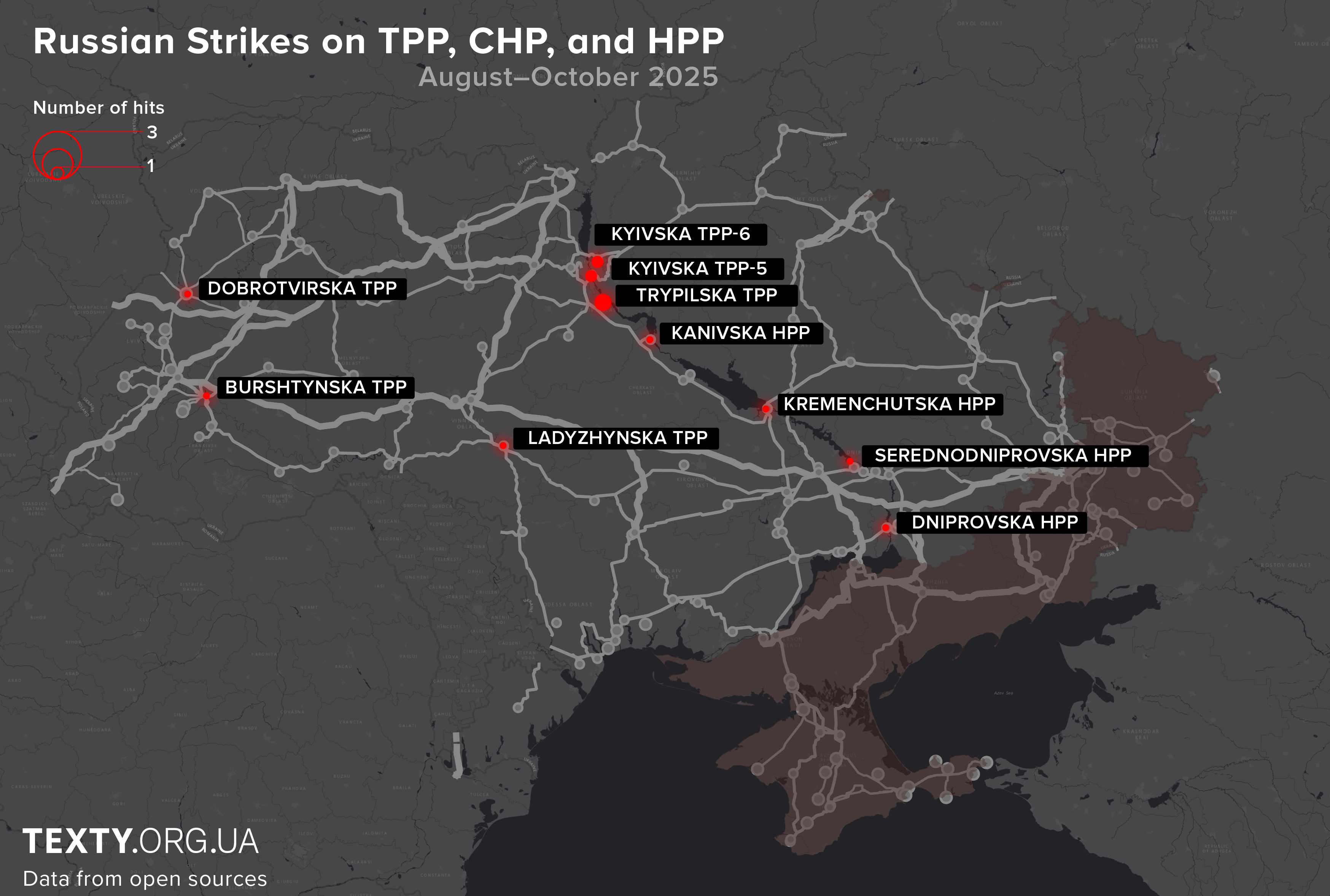Ukraine has survived new attacks on its energy sector. What Russia tried to destroy. Data report by Texty.org.ua
Autumn has begun with massive attacks on Ukraine's energy sector. Texty.org.ua analyzed these attacks over the past three months to assess whether Ukraine's energy sector can withstand another year of similar attacks.
What is Russia's plan?
There is currently much discussion about Russia's strategic plan for Ukraine's energy sector. A widely held view is that Russia intends to divide our energy system into two parts: one on the right bank and in the west, with functioning power plants, and the other on the left bank, which will be turned into a collection of burned-out transformers and power stations.
This scenario would destabilize the entire Ukrainian energy system, with some areas lacking electricity and others unsure how to manage the surplus.
But this assumption can be simplified. Most likely, the Russians will destroy everything related to energy that they can reach. Or, to be more precise, wherever their ammunition allows them to reach. As they have done in previous years.
And if they have not been able to knock out our entire energy sector in the past, this year, they can count on their innovations to do so.
By the beginning of 2025, the enemy had finally “honed” two tools for destroying Ukraine's energy infrastructure, namely drones and ballistic missiles.
“Shahed” drones have radically changed the structure of attacks on Ukrainian energy targets. Of course, the Russians could not afford to strike power substations with missiles before, as it was too expensive. Now this function has been taken over by drones, which the enemy has decided to use to destroy at least all the key substations in the north-eastern region.
The same applies to ballistics: Russia has significantly increased production, accuracy, and the number of ballistic missiles used, primarily through various modifications of the Iskander. Unfortunately, its North Korean ally has also contributed to this. Certain improvements to these missiles have added to the problem — they are now more difficult to shoot down. In other words, in preparation for this season, the Russians have created better opportunities for themselves to “extinguish” Ukraine's energy sector.
However, Ukraine has a natural advantage — a large territory and strategic depth, to use the technical term.
The Shahed drones can fly as far as Lviv, but flying over the entire country, which is covered by air defense systems, is not the same as flying a hundred kilometers to Chernihiv or Sumy. More drones will be shot down on the way to Lviv, and the cost of destruction will increase accordingly. As for ballistics, the range of various types of Iskander missiles is typically limited to 500 kilometers, a significant portion of which the missile must travel through Russian territory from the launch site.
As for cruise missiles, primarily Kalibr, they seem to be in the background for now. Ukraine has considerable experience in shooting them down and has enough systems to do so. We have significantly reduced the number of main launch sites — specifically, ships of the Black Sea Fleet.
The power industry is under systematic attack
Right now, the Russians are primarily targeting the power industry in the Ukrainian regions closest to the front line or their borders, not forgetting, of course, to make occasional “raids” deep into the country, mainly with those same Kalibrs.
Among the priorities is the energy sector of large frontline cities. Settlements that are literally very close to the enemy are particularly unlucky. The Russians regularly strike the energy infrastructure of Chernihiv, Sumy, Nikopol, and Kherson.
As already noted, the relative cheapness of the Shaheds made it possible to attack relatively small energy facilities, in particular, power substations in border and frontline settlements.


If you examine the map of strikes on energy facilities, you can see a clear trend: the Russians are targeting locations, at least in the border areas, where key substations are situated. This is logical: the destruction of substations that supply large networks immediately knocks out entire chains of settlements.
A striking example is Nizhyn in the Chernihiv region, which has effectively endured a barrage of Russian strikes. It seems that the Russians' plan was simply to isolate this city from the outside world, but strikes on the local key substation became part of their campaign. For example, the strike on the substation in Slavutych not only caused numerous power outages for consumers but also a blackout of protective equipment at the Chernobyl nuclear power plant.
Coal and gas
Several gas and coal fields that are strategic for Ukraine's energy sector are within easy reach of the enemy. The situation with coal is the worst. Today, Ukraine's largest coal mine, the Pokrovske Mine, with an annual output of 5 million tons, has been virtually destroyed. In January 2025, it ceased operations and became the site of fierce fighting. Near the town of Rodynske, where fighting is also currently taking place, there is another powerful mine, Krasnolymanska, which is no longer in operation.


It is logical that the Russians focused on destroying the remaining operational coal mines in territories controlled by Ukraine. First and foremost, these are the enrichment plant and mines in Dobropillia, which the enemy struck several times, after which one of them was de-energized, and more than a hundred miners had to be rescued from underground. Unfortunately, it seems that the Dobropillia mines will suffer the same fate as other mines that have already been destroyed.
However, we still have the Pavlohradvuhillya coal mining company, which, before the war, produced up to 20% of all Ukrainian coal. And it is on this company that the Russians have concentrated their latest attacks: at the end of October this year, several attacks were carried out on the company's mines and enrichment plant.
You don't have to be a great forecaster to understand that the attacks on Pavlogradvuhillya's enterprises will continue. The Russians will try to completely cut Ukraine off from its coal.
Unfortunately, key Ukrainian gas fields in the Poltava and Kharkiv regions are also located relatively close to the Russian border. Over the past few months, the enemy has launched multiple attacks against them. In particular, one of the most massive strikes was delivered on October 3 this year. According to Bloomberg, approximately 60% of the country's gas production was lost at that time. Attacks on the gas production and gas transportation industries continue.
At the same time, the Russians tried to “make sure” that Ukraine would not be able to compensate for the losses caused by the destruction of domestic production with imports from the EU. On August 6, the enemy attacked the Orlivka compressor station in the Odesa region, which operates on the route connecting Greek LNG terminals with Ukrainian gas storage facilities via the Trans-Balkan gas pipeline. This pipeline has already supplied liquefied gas from the US and test volumes of Azerbaijani gas.
HPPs and TPPs
To implement their plan to destabilize Ukraine's energy system, the Russians needed to knock out maneuvering capacities. These are power plants that can quickly change the volume of energy production, thus balancing supply and demand. (As is well known, there are peaks in consumption during the day, and nuclear power, which provides the majority of electricity, cannot sharply increase or decrease production. To meet this demand, coal, gas, and hydroelectric power plants are turned on and off.)
Such capacities are especially in demand in emergency situations. First and foremost, this concerns hydroelectric power plants. Throughout the years of full-scale invasion, the Russians have systematically attacked our hydroelectric power industry.


The enemy carried out the last such massive attack on Ukrainian hydroelectric power plants on October 10. Several large hydroelectric power plants of the Dnipro cascade were hit.
At the same time, several thermal power plants on the left bank of the capital, which had already been hit several times before, were also attacked. The goal here is obvious: to leave Kyiv not only without electricity, but also without heat on the eve of the heating season.
The Russians decided not to limit themselves to Kyiv and, on October 22, launched another massive strike on several large thermal power plants in central and western Ukraine. Everything, of course, was planned again before the start of the heating season.
Since the distance was quite large, cruise missiles, primarily Kalibr, were actively used to deliver the strike. Thus, the thesis that the Russians will only strike the left bank of Ukraine is clearly not an absolute axiom. They will strike everywhere they can reach.
Prepare and prepare again
Yes, in some cities, particularly in Nizhyn and Shostka, the situation was not pleasant, but nevertheless, any global catastrophic scenarios were avoided. Power outage schedules were introduced in the country, but they did not become truly draconian.
Preparations for the heating season also continued. According to Ukrainian government officials, the enemy did not succeed in disrupting the process of pumping gas into storage facilities. And even though, after the strikes on Ukrainian production, we are mostly talking about imported gas, the main thing is that it is there, and the accumulation process continues.
However, we are only at the beginning of a long winter. The Russians will continue to attack. Their intentions are clear: to cut off Ukraine's power supply, leave it without heat, and effectively create a humanitarian catastrophe. Therefore, drones, ballistic missiles, and cruise missiles will continue to fly.
The set of targets will likely remain the same: substations, thermal power plants, combined heat and power plants, and hydroelectric power plants — everything the occupiers can reach. It is possible that they will target transformers near nuclear power plants to disrupt the power supply to the nuclear power plants. This is nothing new. They have done this many times before.
But Ukrainian citizens and authorities should, of course, prepare for the worst-case scenarios. Texty.org.ua has written about this more than once. In particular, about the need not only to launch effective warming centers, but also to compile lists of elderly citizens, sick people, etc., in each settlement who will need help in the event of prolonged power and heating outages, and to introduce an effective algorithm for such assistance.
The call to “everyone move to the villages” as a universal solution to the problem in the fourth year of massive attacks on the Ukrainian energy sector is definitely outdated.
Methodology: We obtained information about the shelling from local Telegram channels and those of various government agencies. Therefore, there is a high probability that not all locations of strikes or damage are reflected on the maps. We took information about infrastructure from open sources, namely OpenStreetMap. Data on gas production sites was taken from our previous project.

